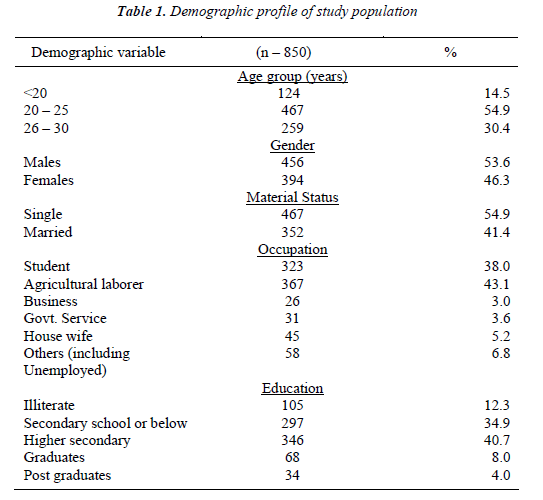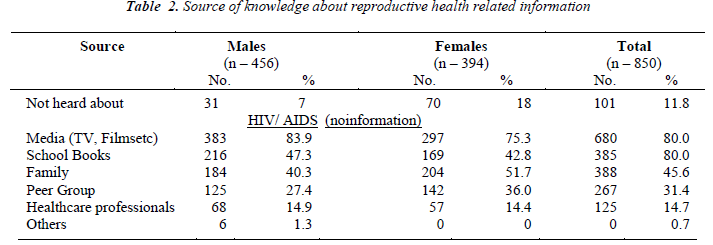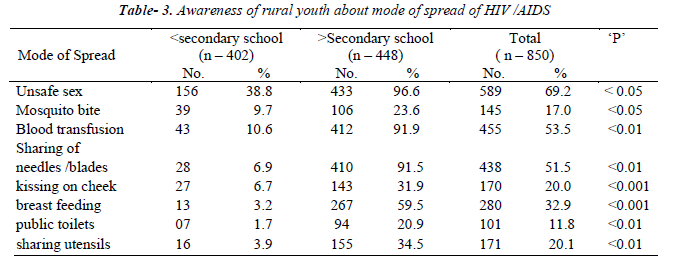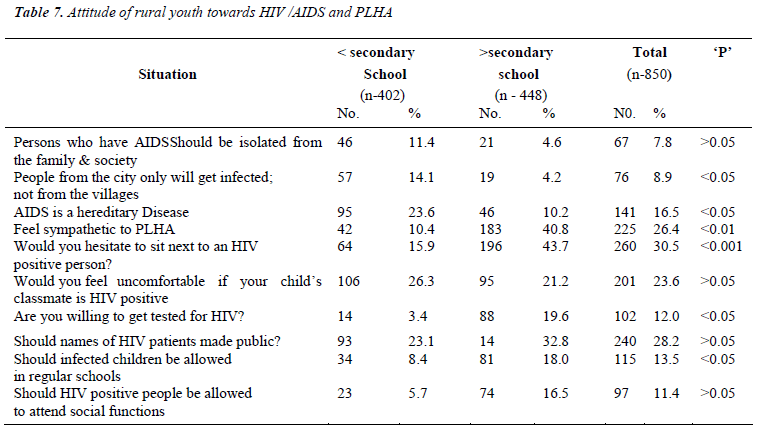- Biomedical Research (2012) Volume 23, Issue 2
Awareness and attitude of youth toward HIV/ AIDS in rural Southern India
K. Malleshappa1, Shivaram Krishna2, Shashikumar3
1Department of Physiology, P.E.S. Institute of Medical Sciences & Research, Kuppam, Chittoor Dist., Andhra Pradesh. Pin: 517 425. India
2Department of Community Medicine, P.E.S. Institute of Medical Sciences & Research,, Kuppam, Chittoor Dist., Andhra Pradesh, Pin: 517 425, India
3Department of Dermatology,Mandya Institute of Medical Sciences,Mandya,Karnataka,India
- *Corresponding Author:
- K. Malleshappa
Department of Physiology
ESI-MC & PGIMSR
Rajaji nagar
Bengaluru
560010;Karnataka,India.
Accepted date: January 21, 2012
Abstract
Community-based cross sectional study done to assess the awareness and attitude of rural young men and women toward HIV/AIDS.The study population included 850 young men and women in the age group of 18-30 years, belonging to Kuppam Mandal,Andhra Pradesh, using a two stage sampling design. Data collection was done using a semi structured pretested questionnaire. The questionnaire consisted a total of 60 questions, 40 regarding awareness about the cause and modes of transmission of HIV / AIDS, & 20 to assess the attitude toward people living with HIV / AIDS (PLHA). Statistical package SPSS version 11.5 was used, chi-square test was conducted & P<0.05 was considered statistically significant. In all, 18% of the women and 7% of men had not heard of AIDS at all. The findings showed that the rural women’s knowledge was poor when compared to men (P<0.05). Level of literacy of men & women was significantly associated with their knowledge of HIV/AIDS (P<0.05), showing that literates had better knowledge than illiterates. There were several misconceptions and false beliefs about cause & spread of the infection which were found to be more prevalent among illiterates. Only about 12% of the respondents were willing to undergo the HIV test. The respondents with less than secondary school education had a discriminatory attitude toward HIV positive people, which was found statistically significant. Only 46% of the youth responded that it could be prevented and 20% knew that HIV could be present in apparently healthy looking persons. This study suggests a need for innovative, comprehensive scientific information particularly targeting the rural youth in order to impart better knowledge and understanding on HIV/AIDS.
Keywords
HIV/ AIDS, awareness, rural youth, attitude
Introduction
India has the third largest number of people living with HIV /AIDS. Among the states, Andhra Pradesh has the second highest number of HIV cases in the country, with a prevalence of 0.90%; prevalence is high in the 15 - 49 age group (88.7% of all infections) indicating that AIDS still threatens the cream of society, those in the prime of their working life. Provisional estimates place the number of people living with HIV (PLHA) in India in 2008 at 22.7 lakhs with an estimated adult HIV prevalence of 0.20% (2008 - 09) [1].
HIV-related stigma and discrimination remains an important barrier in effectively fighting the HIV and AIDS epidemic. Stigma and discrimination can result in people living with HIV / AIDS (PLHA) being shunned by family and the community, poor treatment in healthcare and educational settings, an erosion of rights, and psychological damage. Stigmatization would make people hesitant to get the test done, therefore, more PLHA are unaware that they are suffering from HIV / AIDS, and are thereby putting his/ her sexual partners and /or needle sharers at risk of getting infected, due to lack of precautionary measures [2].
There are several reasons for the stigma toward PLHA among the general population particularly youth in rural areas, one of them could be inadequate and inaccurate information about the modes of transmission of HIV due to cultural or religious beliefs or lack of education [3].
There is an immense need to assess the awareness levels of young men and women in rural areas, towards HIV /AIDS and also periodic evaluation of government’s measures. Most of the studies done in India had focused on high risk group or some single- key population [4, 6, 7, 8, 9].
Even though the state of Andhra Pradesh has the second highest number of reported HIV cases, there is lack of information on awareness and attitude levels among young men and women in rural areas. Thus this study was carried out to assess the level of awareness among the rural youth about HIV / AIDS along with their attitude toward PLHA. The study was carried out in 14 villages of Kuppam mandal in Chittoor District, Andhra Pradesh. Based on the findings, we needed to come up with suitable strategies to correct the misconceptions by information, education and communication (IEC) activities.
Materials & Methods
A community – based, cross – sectional study was conducted in Kuppam Mandal involving 850 rural youth over a period of 5 months (June 2008 – Oct. 2008). Ethical clearance was taken from the Institutional Ethical Committee.Based on the pilot study, the estimated sample size of 850 young men and women in the age group of 18-30years was randomly selected using a two – stage sampling design. In the first stage a random sample of 14 villages of Kuppam Mandal (Taluka) was selected based on the 2001 census using “Probability proportionate to size” (PPS) technique. In the second stage, a simple random sample of 75 households was selected from each of the selected villages.
If the number of eligible respondents was more than one in a household, the names of such respondents were listed in order according to their age and one person was selected randomly, using the random number table. The information was collected using a semi- structured, pre tested questionnaire validated by National AIDS Control Organization (NACO) and procured from Andhra Pradesh state AIDS control society (APSACS). The questionnaire consisted of 60 questions out of which 40 questions to assess the awareness levels of respondents about cause, modes of transmission and prevention of HIV /AIDS and 20 questions to assess the attitude toward people living with HIV / AIDS (PLHA).
During house visits the purpose and nature of the study was explained to the people and informed consent was obtained. On obtaining their consent, the investigator conducted a face–to–face interview to fill the questionnaire. A basic training session, including discussion regarding proforma, in the vernacular language and trial data collection were conducted for the investigators. A total of 5 teams had participated in data collection. Anonymity and confidentiality of respondents were maintained.
Data was analyzed using SPSS version 11.5, chi- square test was used to compare the awareness and attitude toward HIV / AIDS across the educational category & ‘P’ value <0.05 was considered statistically significant. The educational categories were defined as below secondary school (8th standard) and secondary school and above.
Results
The demographic profile of the study population is as shown in Table 1. About 34% of study population had an education level of secondary school or below and about 52% had an education level of higher secondary school and above.
About 7% of males and 18% of females admitted that they had never heard of HIV /AIDS, whereas for about 80% of respondents, the main source of information was television (media) (Table 2).
The awareness of the study population about the modes of transmission of HIV /AIDS is displayed in Table 3. About 69% of participants reported unsafe sex as the mode of transmission, and blood transfusion (53%), sharing of needles (51%) are the other possible modes of getting infected.
Only 32% of study population were aware about breast feeding as one of the modes of transmission. It is important to note that about 17% of respondents incorrectly stated that the disease spreads through mosquito bites, public toilets (11%), sharing utensils (20%), kissing on the cheeks (20%). There was statistically significant differences about the awareness of spread of HIV /AIDS, between the two groups of education levels (P<0.05). The respondents with education level of secondary school and below were less aware about modes of spread of HIV / AIDS, when compared to respondents having education level of secondary school and above.
When enquired whether HIV infection could be prevented, about 46% of youth responded that it could be prevented (Table 4). Those who mentioned that HIV could be prevented, were further asked about various ways by which HIV could be prevented. Having single partner, using condoms, avoiding commercial sex workers and blood checkups were the commonest methods mentioned by both men and women (Table 5).
As HIV infection can be present without any disease manifestation in many healthy looking HIV positive individuals, the youth were asked, to what extent this information was clear to them. Only 20% of respondents knew that HIV could be present in apparently healthy looking persons (Table 6).
Table 7 shows the attitude of rural young men and women about HIV/AIDS and persons living with HIV/ AIDS (PLHA). Among the respondents about 93% were of the opinion that AIDS patients should not be isolated from the society, 26% felt sympathetic toward PLHA; 70% of participants responded that they would not hesitate to sit next to a PLHA in the bus. About 23% stated that they would be uneasy and apprehensive if their child’s classmate had HIV /AIDS, whereas 13% opined that infected children should attend regular schools. Only about 12% of the study group was willing to undergo the test for HIV /AIDS. The respondents with an educational level less than secondary school had a discriminatory attitude toward HIV - positive people, with the opinion that HIV people deserve to suffer, hesitating to sit next to a HIV-Positive person in the bus, and willingness to get tested for HIV which was found to be statistically significant (P<0.05).
Discussion
This study showed that about 18% of females and 7% of males had not heard of AIDS at all. As expected, level of literacy was found to be closely associated with their knowledge of HIV /AIDS, as youth with education level of secondary school & above were found having better awareness than those with education level less than secondary school and also illiterates, particularly in the areas such as cause, spread and nature of the disease. Misconceptions and wrong beliefs associated with HIV /AIDS were found to be more prevalent among young men and women who were illiterates. It was also found that the major source of their awareness was television.
Though 69% of respondents knew that HIV could spread through unsafe sex, blood transfusion (53%), a small group of respondents (20%) stated that HIV spreads by simply touching an infected individual. This proves that knowledge regarding how HIV /AIDS is not spread, is less than the knowledge about how it spreads. Also, there was a disparity in the awareness regarding spread by breast feeding between the two education groups. It is important to note that about 17% of respondents incorrectly stated that the disease spreads through mosquito bites, public toilets (11%), physical contact (kissing on cheeks) (20%).
It was observed in this study that about 7% of participants opined that AIDS patients should be isolated from the society, whereas about 26% of the respondents felt sympathetic towards PLHA. Only about 12% of respondents were willing to undergo a test for HIV; when it was compared with the education levels, it was found to be statistically significant. This could be attributed to the fear of being outcast from society if found as HIV positive.
It is interesting to observe that although 23% of the respondents stated that they would be uneasy and apprehensive if their child’s classmate had HIV /AIDS, about 13% of the participants opined that infected children should attend regular schools. The possible explanation for this finding could be that even though they are sympathetic toward HIV infected children, when it comes to reality and to their own children, they would not take the risk. However, a reasonable justification to such an attitude could be that the parent is concerned about the safety of his /her child, with regard to injuries or mishaps that can occur during school hours. This explains the difference that exists between wanting to reduce stigma and practicing a positive attitude to PLHA in one’s daily life.
In one of the slightly similar study done in Andhra Pradesh (India), the finding being quite different [4]. They found that 51% of the general population wanted names of PLHA to be made public, as compared to 28% in our study.
In another Indian study, 57% felt that people living with HIV /AIDS (PLHA) should be isolated as compared to 7% in our study (5).
Despite the moderately positive attitude of the rural youth toward PLHA and reasonably good levels of awareness regarding the modes of transmission, they also admitted certain misconceptions about the modes of transmission of HIV/AIDS. Despite the vigorous outreach programmes carried out by government along with NGOs, the misconceptions and discriminatory attitudes toward PLHA are the major hindrances in creating better awareness about HIV /AIDS.
As most of the Indian population in rural areas is illiterate and as it was observed from our study that awareness was more among the literates, there is a need to plan and implement new strategies of educating young men and women particularly in rural areas who are at the lower education levels, about HIV /AIDS, modes of transmission. At the same time more focus should be given for changing the perceptions and attitudes toward PLHA. Along with new action strategies, attention should also be given to better implementation of the existing programs to reduce stigma, and inculcate a more positive attitude toward PLHA. These, along with the efforts of the health care professionals should provide an immense progress in the global fight against AIDS.
Conclusion
The study has brought into light some of the important issues about awareness levels among young men and women in rural areas and the action strategies needed for making them aware and in changing their attitudes toward PLHA on an urgent basis. Because HIV infection is a dynamic process and could change as a function of time, more and more similar studies targeted at general public particularly in rural areas are needed at regular intervals to test the results of the preventive measures & efficacy of the existing policies.
Acknowledgement
The authors thank all the research coordinators who were part of the investigating team and all the participants for their co-operation.
References
- HIV data- National AIDS control organization.Available from: http://www.nacoonline.org (accessedon 2011 Jan. 15th)
- Report on the global HIV /AIDS epidemic. Availablefrom:http://www.unaids.org/epidemic_update/report/index.html (accessed on 2011 Jan. 15)
- Government of India- Ministry of health and familywelfare: state wise HIV prevalence (1998 – 2004).Available from: http://www.nacoonline.org (accessedon 2008 June 4th)
- Sudha RT, Vijay DT, Lakshmi. V. Attitudes, awarenessand beliefs in general public toward HIV/AIDS in Hyderabad, a capital city in south India. Indian J med.Sci. 2005;59;307-16
- Sobhan. K, Kumar. TS, Kumar. GS, Ravikanth. R,Adarsha. S, Mohammad AS et al. HIV and AIDS: awareness and attitudes among males in a rural population. Indian J Community Med. 2004;29;141-2
- Sodhi S, Mehta.S. A comparative study of girls of twosenior secondary schools of Chandigarh . Man India1997;77;259-66
- Chakraborty J, Purohit. A, Shah. S, Kalla S, Purohit. S .A comparative study of the awareness and attitude ofHIV/ AIDS among students living in India andmigrants to the united states. J Assoc Physicians India.1996;44:237-9
- Baxi S, Baxi RK, Hazara maya. Knowledge ofHIV/AIDS among college students of BarodaUniversity. J Obst Gyn India 1994;44:7849. Lim VKG, Teo TSH, Teo ACY, Tan KTL. HIV and youths in Singapore-knowledge, attitudes and willingness to work with HIV infected persons.Singapore Med J. 1999; 40: 410-6
- Naik. E, Karpur. A, Taylor R. et al .Rural Indian tribal communities : An emerging high –risk group for HIV/AIDS. BMC Int health hum rights 2005;21:111. Pallikadavath S, Sannath A, Mc whirter JM, stones RW. Rural women’s knowledge of AIDS in the higher prevalence states of India : Reproductive health and socio cultural correlates. Health promot Int2005;20:249-59
- 12. Chuttani C, Gupta SP. Chaturvedi TV. Awareness and knowledge about AIDS among rural population in India. CARC calling 1990;3:4 13. Rogers A, Meundi A, Amma A, Rao A, Shetty P, Antony J et al. HIV- related knowledge, attitudes, perceived benefits and risks of HIV testing among pregnant women in rural southern India. AIDS patients care STDs. 2006;20:803-11






